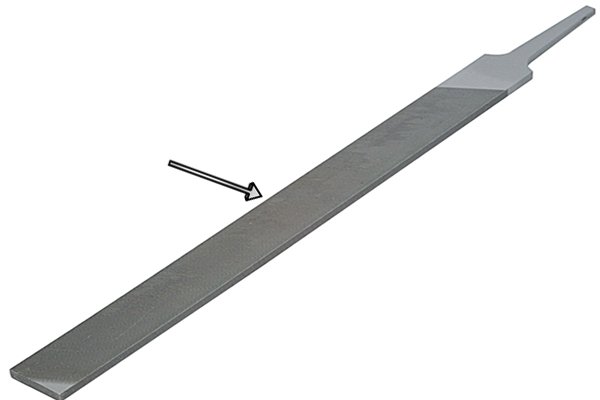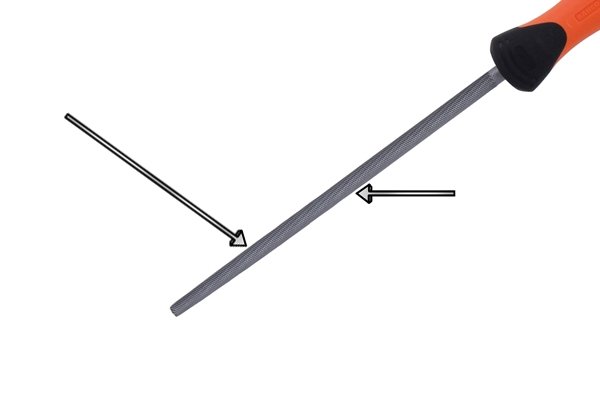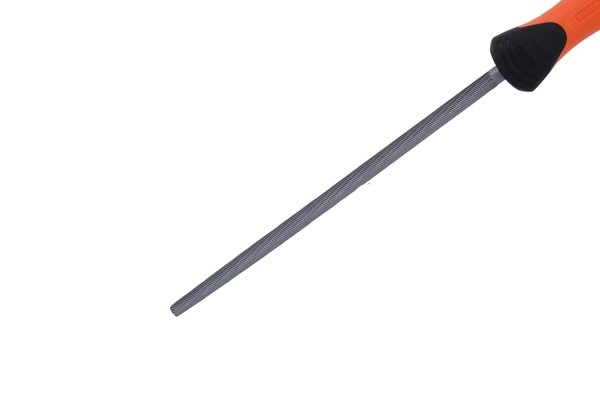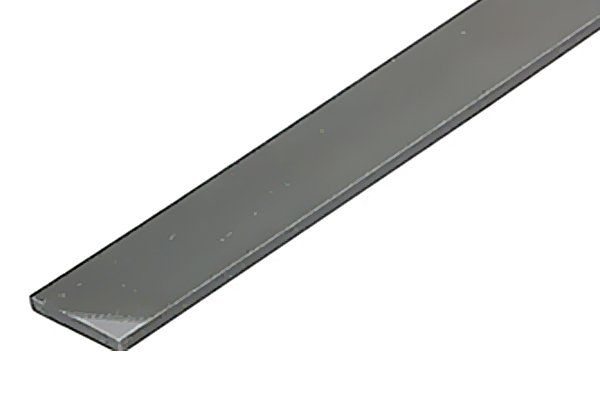Parts of a File
+11
Lex
jomarkpuralanbere
lloydieeeeee
Julie Angala
ruselleee
shiela_tined
Grant Tarine
Peter Shaquelle Daling
denden
Bernadeth
Admin
15 posters
Page 1 of 3 • 1, 2, 3 

 Parts of a File
Parts of a File
Wed Aug 15, 2018 2:49 pm
What is a File?
A file is a tool used to remove fine amounts of material from a workpiece. It is common in woodworking, metalworking, and other similar trade and hobby tasks. Most are hand tools, made of a case hardened steel bar of rectangular, square, triangular, or round cross-section, with one or more surfaces cut with sharp, generally parallel teeth. A narrow, pointed tang is common at one end, to which a handle may be fitted.
What is a Rasp?
A rasp is a form of file with distinct, individually cut teeth used for coarsely removing large amounts of material.
What are the parts of a File?

File Tang

Most metal files are forged with a long spur at one end with no teeth cut into it. This is called a tang.

The tang is the part of the file that fits inside the handle. However, files with tangs are quite often sold without handles.


File Heel

File Face


File Teeth


File Back

What is Barrette File?
Barrette files are machinist's files that are easily identified by the fact they are only cut on one face, meaning there is a large, safe surface that is referred to as the 'back'.
This means only one part of the file can cut a workpiece, leading to a great degree of security against mistakes.
File Edge


These may or may not be cut with teeth depending on the intended purpose of the file. Edges without teeth can be rested against a surface while the file is being used, without wearing it away, which may be a desirable feature when working in close quarters.
File Point


While 'point' is the most common term used for this part of the file, it is not always pointed and can be completely flat. An easy way to remember the name is that it's the part of the file that points towards your workpiece when in use.
A file is a tool used to remove fine amounts of material from a workpiece. It is common in woodworking, metalworking, and other similar trade and hobby tasks. Most are hand tools, made of a case hardened steel bar of rectangular, square, triangular, or round cross-section, with one or more surfaces cut with sharp, generally parallel teeth. A narrow, pointed tang is common at one end, to which a handle may be fitted.
What is a Rasp?
A rasp is a form of file with distinct, individually cut teeth used for coarsely removing large amounts of material.
What are the parts of a File?

File Tang

(TANG)
Most metal files are forged with a long spur at one end with no teeth cut into it. This is called a tang.

(FITTING A FILE INTO A HANDLE)
The tang is the part of the file that fits inside the handle. However, files with tangs are quite often sold without handles.

(HANDLE)
It is recommended that files should always be fitted with handles both for comfort and the prevention of injury.
(PLAIN HORSE RASP)
Files with no tang are referred to as 'plain'. These files are held by their body, in a similar way to an emery board.File Heel

(HEEL)
The heel, also called the shoulder, is the part of the file closest to the tang where the actual body of the file begins. No teeth are cut into the heel.File Face

(FACE)
This is the term used to describe the wide, flat area of the file that usually does all of the work. It may also be referred to as the belly, or the side.
(MULTIPLE FACES)
Depending on the shape of the file, there may be multiple faces, or just one.File Teeth

(DOUBLE CUT CLOSE UP)
Cut into the surface of a file's faces or edges, teeth are the part of the file that give them their abrasive quality.
(HORSE RASP CUT)
The way the teeth are cut has an effect on whether the tool is classified as a file or a rasp. File teeth are created by cutting long lines into the file blank, whereas rasp teeth are punched individually. Rarely, a file will have no teeth on one or more of its faces or edges at all. The term 'safe' is used to describe these surfaces.File Back

(BACK)
Barrette files are made with one convex side opposite the face of the file, which is not cut with teeth. This part of the file is referred to as the back.What is Barrette File?
Barrette files are machinist's files that are easily identified by the fact they are only cut on one face, meaning there is a large, safe surface that is referred to as the 'back'.
This means only one part of the file can cut a workpiece, leading to a great degree of security against mistakes.
File Edge

(EDGE)
The thin surfaces between the faces on a file are called edges.
(SAFE EDGES)
These may or may not be cut with teeth depending on the intended purpose of the file. Edges without teeth can be rested against a surface while the file is being used, without wearing it away, which may be a desirable feature when working in close quarters.
File Point

(POINT)
The end of the file opposite to the tang is called the point, or the toe. While it may seem strange to have the heel and the toe so far apart, remember that your own heel and toes are at opposite ends of your foot!
(FLAT POINT)
While 'point' is the most common term used for this part of the file, it is not always pointed and can be completely flat. An easy way to remember the name is that it's the part of the file that points towards your workpiece when in use.
 Bernadeth
Bernadeth- Posts : 1
Join date : 2018-08-16
 Re: Parts of a File
Re: Parts of a File
Thu Aug 16, 2018 12:43 pm
Can you tell me some safety tips before using a chisel?
 Re: Parts of a File
Re: Parts of a File
Thu Aug 16, 2018 12:49 pm
Bernadeth wrote:Can you tell me some safety tips before using a chisel?
Sure. Before you use a chisel the first and important thing you must do is to wear any safety glasses or a face shield for you to be safe in case of a minor accident
 dendenGURU
dendenGURU- Posts : 10
Join date : 2018-08-19
 Re: Parts of a File
Re: Parts of a File
Sun Aug 19, 2018 4:06 pm
what is the proper maintenance in chisel?
 dendenGURU
dendenGURU- Posts : 10
Join date : 2018-08-19
 Re: Parts of a File
Re: Parts of a File
Sun Aug 19, 2018 4:31 pm
denden wrote:what is the proper maintenance in chisel?
To keep chisel sharp
1.Keep your chisels in a handy storage case between uses will help them keep their sharp cutting edges. It will also be easier finding the specific size of chisel you need at a moment's notice. Storage cases may be a box made of wood with individual compartments for each chisel, or simply a cloth case which can be rolled up and tied.
2. honing guide is a very useful accessory when it comes to sharpening a chisel to an exact angle. By inserting the chisel into the honing guide and setting the angle you can accurately and safely resharpen a dull chisel on a sharpening stone. There are many different makes and models of honing guide available.
3.sharpening stone is used to resharpen dulled chisels and other sharp-edged tools. Many sharpening stones are double-sided, with a coarse grit side and a fine grit side for for different stages of sharpening.
4.Honing oil (also known as cutting oil) is used to lubricate a sharpening stone prior to resharpening a chisel. The oil eases the movement of the chisel blade along the stone.
 dendenGURU
dendenGURU- Posts : 10
Join date : 2018-08-19
 Re: Parts of a File
Re: Parts of a File
Sun Aug 19, 2018 4:34 pm
steps on how to sharpen the chisel
1.To sharpen a chisel you will need a sharpening stone (sometimes called an "oil stone" or "whetstone"), cutting oil and a honing guide
2.Set your stone in a place where it will not easily move or slip. Clamped in a vice is ideal. Note: sharpening stones typically have two faces to them - a coarse face and a fine face. Start with the coarse face.
3.It is important to lubricate your sharpening stone with cutting oil. This will help to ease the movement of your chisel as it is rubbed against the surface of the stone reducing friction and heat build up.
4.Honing guides are extremely useful accessories and well worth the investment if you are going to be sharpening often. You can sharpen a chisel by eye, but for precise angles use a honing guide. Set the chisel in the honing guide to your required angle.
5.Using steady and consistent motion, move the chisel (bevel side down) back-and-forth along the entire face of the stone.
6.Once complete, repeat the sharpening process on the fine face of the stone.
7.The chief reason for adding a micro bevel (or "secondary bevel") is to save you some time. When a chisel becomes dulled through usage, you need only resharpen the micro bevel. You should be able to resharpen a micro bevel several times before you have to resharpen the primary bevel.
8.To add the micro bevel, raise the angle slightly, and move the chisel back-and-forth in steady consistent movements until the bevel is perfectly sharp. Use the whole face of the stone to prevent uneven wear.
9.Remove the honing guide and flip the chisel over so that you can work on its flat back. By rubbing the back of the chisel on the fine face of the sharpening stone, you will keep the back perfectly flat and simultaneously remove any burrs (a rollover or ridge of metal caused by the sharpening process) from the edge of the blade.
1.To sharpen a chisel you will need a sharpening stone (sometimes called an "oil stone" or "whetstone"), cutting oil and a honing guide
2.Set your stone in a place where it will not easily move or slip. Clamped in a vice is ideal. Note: sharpening stones typically have two faces to them - a coarse face and a fine face. Start with the coarse face.
3.It is important to lubricate your sharpening stone with cutting oil. This will help to ease the movement of your chisel as it is rubbed against the surface of the stone reducing friction and heat build up.
4.Honing guides are extremely useful accessories and well worth the investment if you are going to be sharpening often. You can sharpen a chisel by eye, but for precise angles use a honing guide. Set the chisel in the honing guide to your required angle.
5.Using steady and consistent motion, move the chisel (bevel side down) back-and-forth along the entire face of the stone.
6.Once complete, repeat the sharpening process on the fine face of the stone.
7.The chief reason for adding a micro bevel (or "secondary bevel") is to save you some time. When a chisel becomes dulled through usage, you need only resharpen the micro bevel. You should be able to resharpen a micro bevel several times before you have to resharpen the primary bevel.
8.To add the micro bevel, raise the angle slightly, and move the chisel back-and-forth in steady consistent movements until the bevel is perfectly sharp. Use the whole face of the stone to prevent uneven wear.
9.Remove the honing guide and flip the chisel over so that you can work on its flat back. By rubbing the back of the chisel on the fine face of the sharpening stone, you will keep the back perfectly flat and simultaneously remove any burrs (a rollover or ridge of metal caused by the sharpening process) from the edge of the blade.
 Peter Shaquelle DalingGURU
Peter Shaquelle DalingGURU- Posts : 10
Join date : 2018-08-19
 Re: Parts of a File
Re: Parts of a File
Sun Aug 19, 2018 5:26 pm
what is the exact temperature on your storage to store a chisel to remains it quality.
 Peter Shaquelle DalingGURU
Peter Shaquelle DalingGURU- Posts : 10
Join date : 2018-08-19
 Re: Parts of a File
Re: Parts of a File
Sun Aug 19, 2018 5:27 pm
does chisel have it own proper storing?
 Peter Shaquelle DalingGURU
Peter Shaquelle DalingGURU- Posts : 10
Join date : 2018-08-19
 Re: Parts of a File
Re: Parts of a File
Sun Aug 19, 2018 5:28 pm
what are the possible outcomes if your chisel does not go through proper storing?
 Re: Parts of a File
Re: Parts of a File
Mon Aug 20, 2018 1:56 pm
denden wrote:steps on how to sharpen the chisel
1.To sharpen a chisel you will need a sharpening stone (sometimes called an "oil stone" or "whetstone"), cutting oil and a honing guide
2.Set your stone in a place where it will not easily move or slip. Clamped in a vice is ideal. Note: sharpening stones typically have two faces to them - a coarse face and a fine face. Start with the coarse face.
3.It is important to lubricate your sharpening stone with cutting oil. This will help to ease the movement of your chisel as it is rubbed against the surface of the stone reducing friction and heat build up.
4.Honing guides are extremely useful accessories and well worth the investment if you are going to be sharpening often. You can sharpen a chisel by eye, but for precise angles use a honing guide. Set the chisel in the honing guide to your required angle.
5.Using steady and consistent motion, move the chisel (bevel side down) back-and-forth along the entire face of the stone.
6.Once complete, repeat the sharpening process on the fine face of the stone.
7.The chief reason for adding a micro bevel (or "secondary bevel") is to save you some time. When a chisel becomes dulled through usage, you need only resharpen the micro bevel. You should be able to resharpen a micro bevel several times before you have to resharpen the primary bevel.
8.To add the micro bevel, raise the angle slightly, and move the chisel back-and-forth in steady consistent movements until the bevel is perfectly sharp. Use the whole face of the stone to prevent uneven wear.
9.Remove the honing guide and flip the chisel over so that you can work on its flat back. By rubbing the back of the chisel on the fine face of the sharpening stone, you will keep the back perfectly flat and simultaneously remove any burrs (a rollover or ridge of metal caused by the sharpening process) from the edge of the blade.
Thank you for giving an other information
 Re: Parts of a File
Re: Parts of a File
Mon Aug 20, 2018 2:01 pm
Peter Shaquelle Daling wrote:what are the possible outcomes if your chisel does not go through proper storing?
If you don't have a proper caring for your chisel and not store it properly, it might get rusty and it will lessen the sharpness of the blade
 Re: Parts of a File
Re: Parts of a File
Mon Aug 20, 2018 2:08 pm
Peter Shaquelle Daling wrote:does chisel have it own proper storing?
Yes, if you want to keep your chisel safe from and and well-organized, you can make a tool chest. This thing will help you to maintain the quality of the chisel
 Re: Parts of a File
Re: Parts of a File
Mon Aug 20, 2018 2:16 pm
Peter Shaquelle Daling wrote:what is the exact temperature on your storage to store a chisel to remains it quality.
I think the temperature doesn't matter at all to store your chisel. It only needs an additional care like keeping your chisels in a handy storage case to help them keep their sharp cutting edges
 Grant TarineINTERMEDIATE
Grant TarineINTERMEDIATE- Posts : 6
Join date : 2018-08-20
 Re: Parts of a File
Re: Parts of a File
Mon Aug 20, 2018 10:52 pm
How long does a chisel last?
 shiela_tinedGURU
shiela_tinedGURU- Posts : 10
Join date : 2018-08-21
 Re: Parts of a File
Re: Parts of a File
Tue Aug 21, 2018 2:00 pm
What are the importance of file?
 shiela_tinedGURU
shiela_tinedGURU- Posts : 10
Join date : 2018-08-21
 Re: Parts of a File
Re: Parts of a File
Tue Aug 21, 2018 2:00 pm
How helpful to use a file?
 shiela_tinedGURU
shiela_tinedGURU- Posts : 10
Join date : 2018-08-21
 Re: Parts of a File
Re: Parts of a File
Tue Aug 21, 2018 2:02 pm
What are some safety tips to know when using a wood chisel?
 ruselleeeGURU
ruselleeeGURU- Posts : 10
Join date : 2018-08-21
 Re: Parts of a File
Re: Parts of a File
Tue Aug 21, 2018 8:23 pm
A rasp is a form of file with distinct, individually cut teeth used for coarsely removing large amounts of material.[2]
Files have also been developed with abrasive surfaces, such as natural or synthetic diamond grains or silicon carbide, allowing removal of material that would dull or resist metal, such as ceramic.
Files have also been developed with abrasive surfaces, such as natural or synthetic diamond grains or silicon carbide, allowing removal of material that would dull or resist metal, such as ceramic.
 ruselleeeGURU
ruselleeeGURU- Posts : 10
Join date : 2018-08-21
 Re: Parts of a File
Re: Parts of a File
Tue Aug 21, 2018 8:24 pm
Relative tooth sizes for smooth, 2nd cut and bastard files
Files come in a wide variety of materials, sizes, shapes, cuts, and tooth configurations. The cross-section of a file can be flat, round, half-round, triangular, square, knife edge or of a more specialized shape. Steel files are made from high carbon steel
 ruselleeeGURU
ruselleeeGURU- Posts : 10
Join date : 2018-08-21
 Re: Parts of a File
Re: Parts of a File
Tue Aug 21, 2018 8:26 pm
how can we store or maintain a good file?
 Re: Parts of a File
Re: Parts of a File
Wed Aug 22, 2018 4:53 pm
shiela_tined wrote:What are the importance of file?
Files are defined by a number of different attributes. The most important of these attributes are the ones that suit it to a specific task.
The name of the file may provide a DIYer with an indication of what it was designed to do. Its cross section, profile and the pattern of its teeth are vital in terms of determining whether it will be better at shaping, finishing or deburring an object, or sharpening a blade.
 Re: Parts of a File
Re: Parts of a File
Wed Aug 22, 2018 4:54 pm
shiela_tined wrote:What are some safety tips to know when using a wood chisel?
Wood chisels are made in various shapes and sizes and for many uses. Use the correct chisel for the job.
Wear safety glasses, or goggles, or a face shield (with safety glasses or goggles).
Use the right size of chisel for the job.
Choose smooth, rectangular handles that have no sharp edges and are attached firmly to the chisel.
wood chisel
Make sure that the cutting edge is sharp. Dull chisels can be difficult to control and require more effort to do the job.
Check the stock (wood) thoroughly for knots, staples, nails, screws or other foreign objects before chiseling.
Clamp stock so it cannot move.
Adjust your stance so that you do not lose your balance if the tool slips.
Chip or cut with the blade pointing away from yourself.
Keep your hands and body behind the cutting edge.
Use a wooden or plastic mallet with a large striking face on all chisels. Only heavy-duty or framing chisels are made of a solid or molded handle that can be struck with a steel hammer.
Make finishing or paring cuts with hand pressure alone.
When keeping the chisels on the work bench, always place them with the bevel side up.
Place chisels safely within the plastic protective caps to cover cutting edges when not in use.
Replace any chisel that is bent or shows dents, cracks, chips, or excessive wear.
Store chisels in a "storage roll," a cloth or plastic bag with slots for each chisel, and keep them in a drawer or tray.
Replace broken or splintered handles.
Sharpen cutting edges as often as necessary.
Wear eye protection if there is a risk of eye injury from particles released from the workpiece or when sharpening.
 Re: Parts of a File
Re: Parts of a File
Wed Aug 22, 2018 4:56 pm
ruselleee wrote:how can we store or maintain a good file?
By storing it in a proper place like using a storage box to maintain the quality and keep away from damage
 jineGURU
jineGURU- Posts : 10
Join date : 2018-08-20
 Re: Parts of a File
Re: Parts of a File
Thu Aug 23, 2018 12:44 pm
Before using this tool inspect it to ensure that it is in good condition. Do not use a file as a pry bar, hammer, screwdriver or chisel.When using a file or a rasp, grasp the handle in one hand and the toe of the file in the other.Do not hammer on a file.  This is based on what I have read
This is based on what I have read  Do you agree ?
Do you agree ?
 Re: Parts of a File
Re: Parts of a File
Thu Aug 23, 2018 12:50 pm
jine wrote:Before using this tool inspect it to ensure that it is in good condition. Do not use a file as a pry bar, hammer, screwdriver or chisel.When using a file or a rasp, grasp the handle in one hand and the toe of the file in the other.Do not hammer on a file.This is based on what I have read
Do you agree ?
Yes
Page 1 of 3 • 1, 2, 3 

Permissions in this forum:
You cannot reply to topics in this forum